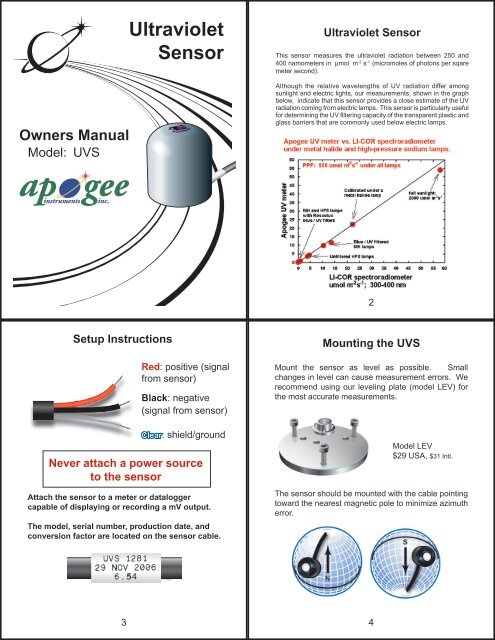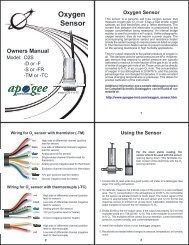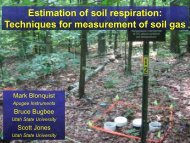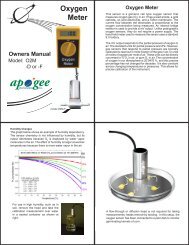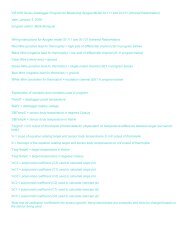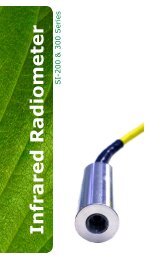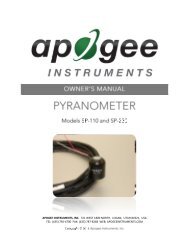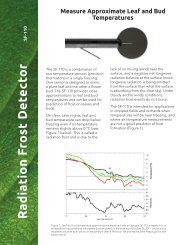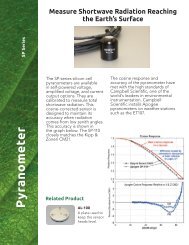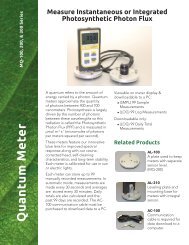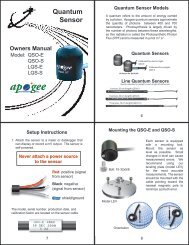Ultraviolet Sensor (UVS) - Apogee Instruments
Ultraviolet Sensor (UVS) - Apogee Instruments
Ultraviolet Sensor (UVS) - Apogee Instruments
Create successful ePaper yourself
Turn your PDF publications into a flip-book with our unique Google optimized e-Paper software.
Owners ManualModel: <strong>UVS</strong><strong>Ultraviolet</strong><strong>Sensor</strong><strong>Ultraviolet</strong> <strong>Sensor</strong>This sensor measures the ultraviolet radiation between 250 and400 namometers in μmol m -2 s -1 (micromoles of photons per sqaremeter second).Although the relative wavelengths of UV radiation differ amongsunlight and electric lights, our measurements, shown in the graphbelow, indicate that this sensor provides a close estimate of the UVradiation coming from electric lamps. This sensor is particularly usefulfor determining the UV filtering capacity of the transparent plastic andglass barriers that are commonly used below electric lamps.2Setup InstructionsRed: positive (signalfrom sensor)Black: negative(signal from sensor)Clear: shield/groundNever attach a power sourceto the sensorAttach the sensor to a meter or dataloggercapable of displaying or recording a mV output.The model, serial number, production date, andconversion factor are located on the sensor cable.Mounting the <strong>UVS</strong>Mount the sensor as level as possible. Smallchanges in level can cause measurement errors. Werecommend using our leveling plate (model LEV) forthe most accurate measurements.Model LEV$29 USA, $31 Intl.The sensor should be mounted with the cable pointingtoward the nearest magnetic pole to minimize azimutherror.3 4
Full Sunlight(170 μmolm -2 s -1 )CalibrationUV sensors are calibrated to ouput approximately 0.15 mVper μmol m -2 s -1 .Conversion factorWhy this sensor cannot selectivelymeasure UV-B Radiation (280-320 nm)Our measurements confirm those of others and indicate that less than0.4 % of the photon flux from sunlight falls below 320 nm; 2.3 % fallsbetween 320 and 350 nm, and 6 % falls between 350 and 400 nm. Althoughthe UV radiation between 250 and 320 nm is critically importantin photochemical and photobiological reactions, only about 5 % of the UVphotons are in this range. Because only a small fraction of the photonsare in the UV-B range, this meter cannot be used to selectively measureUV-B radiation. The sensor is sensitive to UV-B radiation, but it is includedwith the UV-A radiation to provide a total measurement of UV radiation.Use the conversion factor (foundon the tag near the pigtail leads)to convert the mV signal from thesensor to UV radiation in μmolm -2 s -1 (multiply the mV output bythe conversion factor to yield UVradiation in μmol m -2 s -1 ).exampleconversionfactor:6.54<strong>Sensor</strong> Output (26 mV)UV radiation = sensor output x conversion factor= 26 mV x 6.54 = 170 μmol m -2 s -12Effects on OutputLevelThe sensor must be exactly horizontal for the mostaccurate measurement. The largest error is oftencaused by small changes in the position of the sensor.The sensor should be mounted with the cable pointingtoward the nearest magnetic pole.Cosine responseSome of the radiation coming into a sensor at lowangles is reflected, which causes the reading to be lessthan it should be. The cosine-corrected head helps tocapture radiation at low angles. The cosine error fortypical applications is less than 10 %.Temperature responseThe temperature response is about 0.1 % per degreecelsius. This temperature error is insignificant for mostapplications.Long-term stabilityThe output of all radiation sensors tends to decreaseover time as the detector ages. Our measurementsindicate that the average decrease of the sensor isabout 1 % per year. We recommend returning thesensor for recalibration every 3 years.SpecificationsAbsolute accuracy ± 10 %Uniformity ± 5 %Repeatability ± 1 %Output Responsivity Approximately 0.15 mV per μmol m -2 s -1In full sunlight Approximately 26 mV (170 μmol m -2 s -1 )Linear range 0 to 400 µmol m -2 s -1SensitivityCalibrated to approximately 6.5 μmol m -2 s -1 per mVInput powerNone, self-poweredOperating environment Can be submerged underwater (with or withoutmounting bolt).MaterialsPVC head, potted solidCable3 meters of shielded, twisted-pair wire withSantoprene casing, ending in pigtail leads.Additional cable $ 1.95/meter.Dimensions2.4 cm diameter, 2.75 cm highMass70 g (with 3 m lead wire)Warranty1 year parts and labor435-792-4700www.apogeeinstruments.comtechsupport@apogeeinstruments.com3 4


